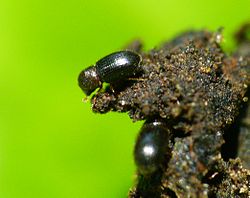| Hypothenemus | |
|---|---|
 | |
| Hypothenemus seriatus | |
| Scientific classification | |
| Kingdom: | Animalia |
| Phylum: | Arthropoda |
| Class: | Insecta |
| Order: | Coleoptera |
| Suborder: | Polyphaga |
| Infraorder: | Cucujiformia |
| Family: | Curculionidae |
| Subfamily: | Scolytinae |
| Tribe: | Cryphalini |
| Subtribe: | Cryphalina |
| Genus: | Hypothenemus Westwood, 1836 |
| Diversity | |
| at least 280 species | |

Hypothenemus is a genus of bark beetles in the family Curculionidae. There are more than 200 described species in Hypothenemus. They are common in tropical and subtropical areas worldwide, and found less often in temperate areas of eastern North America and eastern Asia. The small beetles are typically 0.6 mm to 2.2 mm in length, males smaller than females. [1] [2]